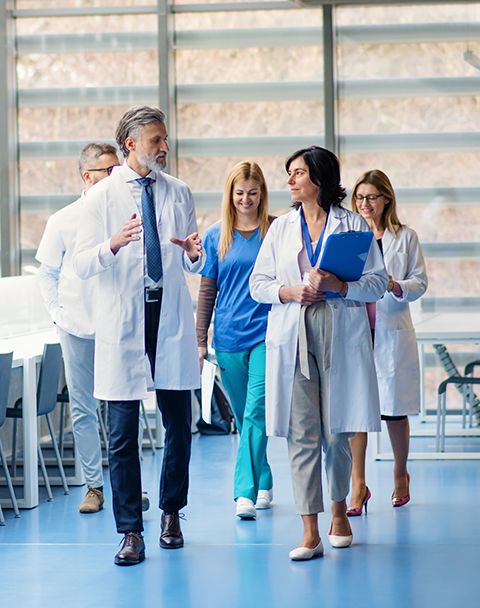
Oncology Salary Trends You Need to Know
Gain key insights about the latest in Oncology salaries, so you can make informed, empowered decisions about your career goals.
April 29, 2025
The last several years have been instructive and transformative for the field of Oncology: A global pandemic, a looming labor shortage, and huge leaps forward in AI, machine learning and genomic medicine. The specialty has proved to be resilient, and in the face of rising cancer rates, it’s critically important.
Looking at emerging salary trends is one way to get a clearer understanding of where Oncology is headed.
At Provider Solutions & Development (PS&D), our goal is to connect Oncologists at every stage of their career with the knowledge, guidance and job opportunities they need to achieve their goals.
For many physicians, including those specializing in Oncology, pay is steadily increasing, but how does its level of compensation stack up against other specialties? What does the data tell us about compensation across different demographics, like gender, race and geography? How are concerns about student loans and malpractice insurance affecting pay?
Let’s explore the current state of Oncology salaries, Oncology salary trends and how to make informed choices about the next vital steps in your Oncology career.
The Current State of Oncology Salaries
According to Medscape’s “2024 Physician Compensation Report," Oncologists earned, on average, $464K annually.
Despite a slim majority of physicians feeling they’re underpaid given the demands of their work, most Oncologists feel they’re fairly compensated.
While some might voluntarily add a few extra hours to their regular schedule for pursuits like consulting, medical writing or speaking engagements, the vast majority of Oncologists don’t seek other work to supplement their income.
This general contentment with pay could be attributed to Oncologists finding fulfillment and empowerment through their work while feeling confident that the practice of Oncology is positioned for growth and innovation.
But what does the data tell us about the future of pay for Oncologists? Let’s explore the emerging trends in Oncology salaries.
Oncology Salary Trend #1: Salaries Will Continue to Steadily Increase
According to Medscape’s annual reporting on Oncology salaries, there has been a significant upward trend in compensation.

These numbers represent total compensation for surveyed physicians, including any money earned beyond salary, such as incentive bonuses or profit-sharing. While some years showed bigger shifts in compensation than others, incremental growth is a positive thing for the profession.
When it comes to compensation for all physicians surveyed, Oncologists fall just below the uppermost earners in medicine:
- Orthopedics — $558K
- Cardiology — $525K
- Gastroenterology — $512K
- Dermatology — $479K
- Oncology — $464K
Another factor likely contributing to the steady growth of Oncology salaries is demand — and the growing supply.
Unlike other specialties, researchers at the National Resident Matching Program analyzed Oncology-related data to find that the number of annual training positions grew 66% and the number of interested applicants increased 34%.
Why the drastic increase in growth? One likely reason is the escalation of cancer diagnoses in the United States.
The risk of dying from cancer has steadily declined because of advanced treatment techniques, the success of early intervention tactics and a decrease in smoking. Despite these improvements, our aging population and a spike in the diagnoses of many of the most common cancers have increased the demand for Oncology specialists.
This places Oncologists at every stage of their career in a prime position to achieve their goals, including those pertaining to a competitive compensation package.
Oncology Salary Trend #2: Geography, Gender and Race Will Continue to Be Factors in Compensation
Whether you’re just entering your career in Oncology or looking to take the next step, knowledge is power.
If your career goals include potentially moving to a new state, it’s important to understand the nuances of Oncology salaries from state to state. For instance, the difference in average compensation between the highest and lowest paying states for Oncologists is over $150,000.
Oncology Salaries: Highest-Paying States
- Washington — $444K
- District of Columbia — $443K
- New York — $429K
- Massachusetts — $428K
- Alaska — $422K
Oncology Salaries: Lowest-Paying States
- Florida — $293K
- West Virginia — $304K
- Arkansas — $324K
- Georgia — $331K
- Louisiana — $335K
- Kentucky — $341K
Just as there are disparities in pay from state to state, there are also disparities in pay related to race and gender.
While 58% of Oncologists in the field are women, male Oncologists outearned their female counterparts by 31%.
PS&D has been an active voice in sharing best practices on how health systems can close the gender pay gap, including the following:
- Pay Transparency — Share benchmark compensation data and use it to determine starting salaries.
- Centralized Referral System — Funnel all referrals through a centralized hub to remove the opportunity for conscious or unconscious bias.
- Equitable Promotion Guidelines — Create promotion protocols that elevate more women physicians to higher-ranking positions.
- Pre-defined Pay Structures — Use pay structures based on board certifications and specialty.
- Panel and Quality Incentives — Tie some compensation to other metrics, like quality and/or panel size.
Similarly, researchers have found that there are pay disparities across races and ethnicities for Hematologist-Oncologists.
These same researchers found that white Oncologists have the highest average salary ($327K) compared to all other ethnicities surveyed, and that Black Oncologists have the lowest average salary ($301K). With the growing importance of representation in improving health outcomes, many organizations are already taking steps to ensure equity in salary among their clinicians with more hospitals and health systems sure to follow.
Oncology Salary Trend #3: Sub-specialties Are Changing How Care Will Be Delivered
Oncologists aren’t the only clinicians making an impact in the world of Oncology care.
Hematologist-Oncologists and advanced practice providers (APPs) — like Oncology physician assistants and nurse practitioners — all make vital contributions to the field of Oncology.
These roles are distinct from an Oncologist. They have different educational requirements, patient treatment is different, and so is their respective pay.
Here’s an overview of what average Oncology sub-specialty salaries look like:
Salaries for Sub-specialized Oncologists and APPs
- Hematologist-Oncologist — $346K
- Radiation Oncologist — $466K
- Pediatric Oncologist — $343K
- Gynecologic Oncologist — $368K
- Oncology Physician Assistant — $148K
- Oncology Nurse Practitioner — $139K
The wide range of growing specialties in Oncology could mean exciting developments in cancer treatments. Every specialization represents new possibilities for discovering and sharing treatment methods that will innovate the field and reduce cancer mortality.
Oncology is a fast-moving field, where even just a few years can bring a drastic difference in the approach to treatment.
As these specializations grow, so will the salary opportunities, opening the field for professionals to achieve professionally and financially rewarding careers.
Oncology Salary Trend #4: Student Loans and Malpractice Considerations Will Play an Increasingly Important Role in Oncology Compensation Negotiations
In any field of medicine, student loans are critical in funding a medical student’s education:
- In 2023, 70% of medical students graduated with some level of debt.
- Of those students, 50% had at least $150,000 in medical school-specific debt.
- The average medical school debt increased by nearly 50% between 1998 and 2019.
The constant stress of debt coupled with high interest rates can be overwhelming, and these realities can have a significant impact on career choices.
How Student Debt Influences Physician Salary
Some hospital systems are bridging the gap between compensation and debt through student loan forgiveness incentives.
These incentives can be very appealing. For example, according to an American Medical Association study, “The average amount of loan repayment offered was $98,665 in 2022-2023.”
These incentives don’t come without commitments, of course. In the same study, it was found that 84% of applicants who accepted offers featuring these incentives were required to stay in their position for at least three years.
The future of Oncology salaries includes thinking creatively beyond standard compensation — professionals who leverage student loan forgiveness programs and bonuses might find debt relief earlier while setting themselves up for long-term career flexibility.
How Malpractice Insurance Influences Physician Salary
Another financial factor influencing physician salary is malpractice insurance.
Though malpractice insurance rates can vary, depending on specialty, city and state, and claims history, the cost of this coverage can be significant — between $30K to $50K in annual premiums for surgeons, and anywhere from $4K to $12K annually for many specialists.
For larger healthcare organizations, like hospital systems or university healthcare institutions, malpractice insurance is provided but is typically baked into an overall compensation package.
A 2022 Medscape study found that Oncologists were less likely to be named in malpractice suits than other specialties.
Positive stats aside, it is always important to get a clear picture of:
- Who is responsible for malpractice insurance
- What percentage of total compensation malpractice insurance represents
- Precisely what the coverage entails, including details like malpractice tail coverage
Again, while most larger healthcare organizations include malpractice coverage as a part of an overall compensation package, understanding the details of that package will empower Oncology professionals to make a more informed decision about the future.
Key Takeaways in Oncology Salary Trends
- Oncology salaries are steadily increasing — Remember that there are ways to leverage the high demand to create a stronger compensation package.
- Geography, gender and race often have an impact on salary — Look for jobs at institutions with leadership that advocates for and empowers diverse talent.
- Sub-specialties offer highly competitive opportunities — Those seeking a more focused field of practice while still working in Oncology have many options to consider.
- Student loan forgiveness and malpractice insurance can have a big impact on salary — Make sure to understand the options when it comes to salary, loan forgiveness, and other protections when considering new opportunities.
- Find the right recruiting partner — Job seekers deserve support from experts who will help them find the right opportunities and help them negotiate.
Are You Ready for Your Next Opportunity? PS&D Can Help.
Provider Solutions & Development is different from other physician recruitment firms — we don't have quotas, and we don't work on commission. But we do specialize in supporting Oncologists at every stage of their career.
Our north star is to offer our expertise and guidance to help you reach your professional goals and find personal fulfillment.
Founded and owned by Providence, we recruit for Providence Cancer Institute, Swedish Cancer Institute and dozens of other cancer programs for health systems across the country. We've helped hundreds of providers find their next step in Oncology. Reach out to our team today to learn more.
Additional Articles

Job Transition
A Comprehensive Physician Job Transition Checklist

Contracts & Negotiations
